marketplace
Focus
on Tonometers
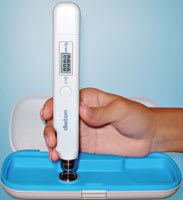
BiCOM,
Inc.
BiCOM introduces a transpalpebral Diaton tonometer. Diaton Tonometry is a unique approach to measuring intraocular pressure (IOP) through the eyelid. There is no contact with the cornea and no anesthesia or sterilization is required.
Portability, safety and simplicity make the Diaton tonometer ideal for a wide range of applications: for mass screening of the population, at the patient's bedside, in geriatric homes, in children hospitals, for the military and for home use.
BiCOM, Inc.
Phone: (877) 342-8667
TX-F FULL AUTO TONOMETER
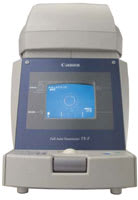
Canon Medical Systems
A Division of Canon U.S.A., Inc.
Canon uses innovative technology in its TX-F full auto tonometer. Once a patient's eye is seen on the monitor, the start button can be pressed and the exam is over in seconds. When operated in a full auto mode, the TX-F performs alignment, focusing and measuring for one eye and then moving to the other eye in one continuous series of operations. Users simply wait for the printout. The entire process is remarkably quick, and the unit's 3-D tracking system helps to ensure that readings are reliable.
Canon Medical Systems
A Division of Canon U.S.A., Inc.
Phone: (800) 970-7227
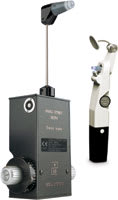
Haag-Streit
The average deviation with a Goldmann Applanation Tonometer does not exceed +/- 0.5 mm Hg in any one single examination. Other features include: measurements performed in conjunction with other routine examinations at the slit lamp, no massaging effects because repeated measuring does not reduce the ocular pressure, no standardization and calibration difficulties, the IOP in mm Hg is found by multiplying the drum reading by 10, and the small volumetric displacement of 0.56 mm3 increases the intraocular tension by about 2.5%, so scleral-rigidity is not taken into account.
The Applanation Tonometer 900 is a powerful accessory to the Haag-Streit 900 series slit lamps. The tonometer is also compatible with many other brands of slit lamps.
The Perkins Hand-Held Applanation Tonometer is portable, making it easier to examine bedridden and pediatric patients. Based on Goldmann principles and utilizing the original Goldmann or Tonosafe-disposable prisms, the Perkins combines proven technology with the flexibility of a handheld instrument. The Goldmann Applanation tonometer is on the left side of the figure and the the Perkins Tonometer appears on the right.
Haag-Streit
Phone: (800) 787-5426
PULSAIR EASYEYE NON-CONTACT TONOMETER

Keeler Instruments Inc.
Keeler's Pulsair EasyEye handheld non-contact tonometer has a unique "seeing eye" optical system for checking patients' IOP. It may be used as a handheld instrument, or is slit-lamp adaptable and has a built-in printer. The Pulsair EasyEye's precision performance is calibrated to read within ±1 mm Hg of Goldmann tonometry. The handpiece makes the instrument an effective way to obtain IOP readings on patients who find it difficult to sit at a slit lamp. The Pulsair EasyEye is accurate, portable and relatively easy to use. There is no pre-test preparation and minimal risk of cross infection.
Keeler Instruments Inc.
Phone (800) 523-5620
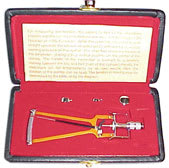
KHOSLA MEDICAL, Inc.
The Schiotz Tonometer features accurate weight and reliable performance, says Khosla Medical, Inc. It comes complete with an instructional pamphlet and calibration scale and is housed in a case that consists of a base with slots to store 7.5-, 10- and 15-gram weights.
Khosla Medical, Inc.
Phone: (408) 996-0205
ARRAY OF TONOMETERS

Kowa
Kowa Optimed offers three tonometers; the handheld Applanation HA-2, Automated KT-500 and the recently introduced Non-Contact KT-800.
The Kowa Handheld HA-2 is a lightweight instrument that offers the ultimate flexibility and mobility to use the instrument with a single hand, says Kowa. Its patented one-spring mechanism design assures correct readings regardless of patient posture. Built-in illumination enables the instrument to be operated regardless of available light and the direct reading type precision dial requires no conversion table to change readings.
Kowa's Automated KT-500 offers automatic vertical and horizontal positioning by simply placing the alignment dot inside the outer circle. Measurements are performed with non-invasive soft air and measurements are not processed if the eye is not opened sufficiently.
The KT-800 offers 3D auto alignment function, soft airflow, electronically operated chin rest and high-speed printout.
Kowa Optimed, Inc.
Phone: (310) 327-1913
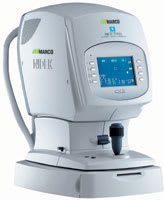
Marco
The M3, an automatic refractor, keratometer and noncontact tonometer, incorporates three diagnostics for refractive power, corneal curvature and IOP, to offer the first combination unit of its kind.
In addition to improving office efficiency, the combination of three instruments into one provides space-saving options. The M3 offers a new ergonomic design, a combination of technologies and a diagnostic solution that is exclusive to Marco. The M3 will also interface with all other Marco Vision Diagnostic Systems within a practice.
Marco
Phone: (800) 874-5274
TONOMETER/BLOOD FLOW ANALYZER

Paradigm Medical
Paradigm's Tonometer/Blood Flow Analyzer (BFA) is fast and comprehensive, says the
company. The BFA provides highly accurate and sensitive tonometric measurements.
It measures IOP and records pulsatile ocular blood flow by measuring IOP variations
over time at a rate of 200 samples per second. In one automatic 10-second measurement,
information is captured and displayed on the screen, and data are printed on a concise
patient record. The BFA provides repeatable measurement of ocular blood flow and
IOP. The BFA analyzer assists in early detection of new glaucoma cases and improves
the ability to monitor and manage current
glaucoma patients.
Paradigm Medical Industries
Phone: (801) 977-897
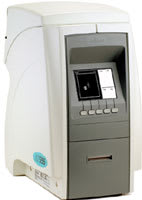
Reichert, Inc.
The AT555 tonometer features fully automated operation ensuring fast, error-free readings and easy operation, says Reichert. The AT555 nosepiece contains an array of bright red LEDs, which provide an obvious visual cue to the patient for fast fixation and alignment. An "eye" icon on the display shows the operator how the instrument's auto alignment system is positioning itself to make a measurement. The AT555 has no chinrest, joystick or elevation controls; patients simply lean against the forehead rest.
The PT100, a portable, handheld, noncontact tonometer is also available from Reichert, Inc.
Reichert, Inc.
Phone: (888) 849-8955
CT-80 NON-CONTACT TONOMETER

Topcon
Topcon's CT-80 Non-Contact Computerized Table Tonometer features a triple patient safety function with an adjustable safety stopper set by the operator, a "too-close" display to guide alignment and a warning buzzer to inform the operator if the cornea and the instrument are too close to each other. The CT-80 also features Topcon's innovative dual-sensor measuring system that eliminates atmospheric and environ- mental influences on measuring results. Additional benefits include a faster measuring time, an internal fixation target and alignment via infrared illumination for increased patient comfort. A built-in printer delivers up to three measurements and an average value for each eye.
Topcon
Phone: (800) 223-1130

Woodlyn
The Woodlyn Applanation Tonometer adapts to all slit lamps of the HR design. The tonometer is permanently mounted to the slit lamp for security and the notched position ensures exact centering.
Woodlyn
Phone: (800) 331-7389
PASCAL DYNAMIC CONTOUR TONOMETER

Ziemer
The PASCAL Dynamic Contour Tonometer obtains accurate IOP regardless of corneal biomechanical properties like thickness, elasticity, edema, radius, astigmatism or diameter, says Ziemer. Even though it looks like a high-tech version of an applanation tonometer, it is not one. The PASCAL works by having its cornea-matched tip rest gently on the cornea in such a way as to get the cornea to "relax" into the tip. When this occurs, corneal biomechanics are neutralized and no longer influence the reading of IOP. At that point, a piezzo electric pressure sensor begins measuring the ocular pulse curve from which the instrument derives IOP and Ocular Pulse Amplitude (OPA). The PASCAL has been scientifically validated in clinical studies that have been published in peer-reviewed journals.
Ziemer Ophthalmic Systems
Phone: (866) 541-8326








